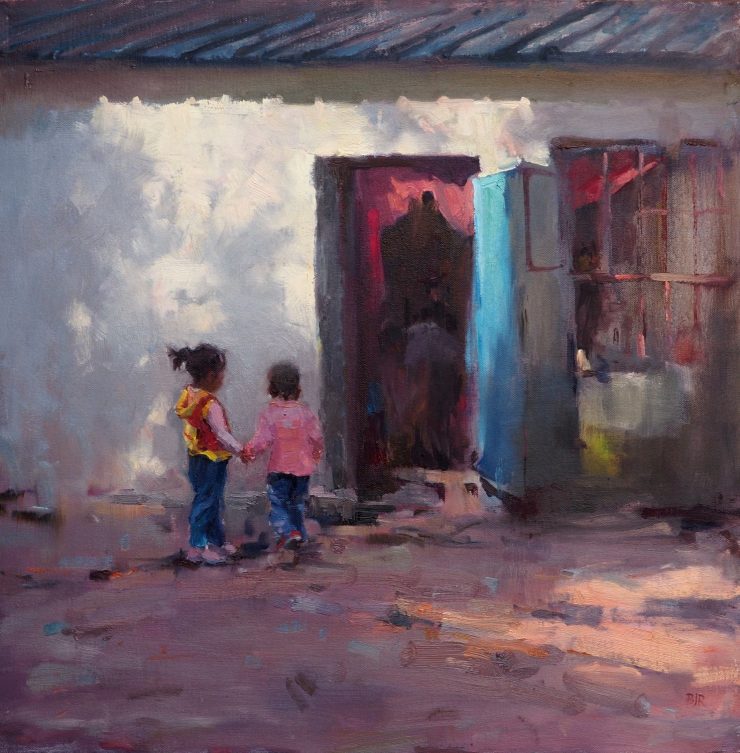(Get free painting tips and plein air painting techniques sent straight to your inbox or on my social media.)
Many students ask if direct sunlight damages oil paintings, or if they can put their oil paintings out in the sun to make them dry more quickly. Whilst you can do this, there are good reasons to avoid it.
Damage to oil paintings from exposure to sunlight or a heat source
Putting the painting in a position where it gets hot for an extended period of time will ultimately damage the oil painting. Also oil paintings are damaged by exposure to ultraviolet radiation. When oil paint is heated a chemical reaction takes place that alters the oil paint. This results in a change in the colors which can be visible to the viewer.
The discoloration and deterioration typically occurs at the surface of the oil painting after prolonged exposure to heat, for example from a sunlit window, or exposure to other sources of heat such as being placed near to a fire or fireplace. There is additional damage due to ultraviolet radiation if you place the painting where it gets direct sunlight.
However, it does take some time for the damage to occur, so for a short time it may not be too serious a problem. Most oil paintings will not suffer much damage over a short time. There is more of a problem if there is some exposed canvas in the painting. These is because sunlight can damage canvas, but it will not damage the canvas through the oil paint.)
A note on watercolors in sunlight
You should not place watercolors in direct sunlight. They will fade very quickly. The same goes for works on paper and photography, as even most indirect light can cause fading. The painting will fade even if the painting has a frame made of UV plexi glass, since the plexi glass does not prevent all sun damage.
What affects the drying time of oil paints
The drying time of oil paints depends on these factors:
- temperature – the warmer the temperature the faster the drying time.
- pigment – different pigments dry at different speeds. Cadmiums dry extremely slowly. Earth pigments dry extremely quickly.
- medium – each medium you use to mix with the paint will affect the drying time in a different way.
How To Make Your Oil Paintings Dry Quickly
Here are some ways to help your oil paintings dry quickly. You might want to use these methods for when you are traveling for example.
- Use alkyd white instead of normal white to mix with your oil paints. This will make your paintings dry in a day or two, compared to a week. You might have some problems with yellows where you have not added white unless it is a quick drying yellow. Generally Cadmium Yellows PY35 (based chemically on Cadmium Zinc Sulphide) dry slowly but the less expensive and commonly used Hansa Yellows PY1, PY2, PY3, PY6, PY9 (based chemically on monoaso, arylamide) dry quickly.
- Use an alkyd medium with your colors. I typically find this is not such a good method as the paint dries too quickly during the painting session.
Glazing with fast drying mediums
If you are glazing an oil painting you can use a medium such as Winsor & Newtons Liquin to make the glaze dry quicker.
Caution
You should not use this method on top of an impasto oil painting as it is unlikely the underlying paint is fully dry. In general you want to put slower drying layers on top of faster drying layers. If you put a fast drying layer on top of a slow drying layer, your oil painting is likely to crack.
Fat Over Lean Rule
If you paint an oil painting using different layers, each successive layer needs to be more flexible than the one underneath. To do this, add more medium to each successive layer. This makes each new layer more flexible than the previous one and prevents the painting from cracking. Another way of expressing this rule is ‘Flexible over Non-Flexible.’
Thick Over Thin Rule
If you like to paint using impasto paint (or thick paint), it is best to place the thick brushstrokes over thinner layers of paint. The reason for this is because the thin layers dry more quickly. So if you want to build up the surface of your painting using an impasto impressionist style, then avoid putting thinner layers on top of your thick impasto paint. If you do that you painting is likely to crack.
You can get around this limitation somewhat by applying the fat over lean rule. If you add more oil to the upper thin layer, it will slow the drying down and lower the chance of it cracking.
Slow Drying Over Fast Drying Rule
Use fast drying colors in your under layers. If you paint a fast drying layer on top of a slow drying layer then your painting may crack. This is because the fast drying layers will have dried on top of layers that are still in the process of drying out. When paint dries it moves, so if the topmost layer is already stiff, this movement in the lower layers will crack it.
You can similarly get around this limitation by applying the fat over lean rule. If you add more oil to fast drying paint, it will slow down the drying time and lower the chance of it cracking.
References
- Physical Properties of Modern Artists’ Oil Paints. Recent CMOP progress at the Getty Conservation Institute and CATS
- New tools for managing daylight exposure of works of art: case study of Hambletonian, Mount Stewart, Northern Ireland
Thank You
Thank you for taking the time to read this article. I hope you find it useful. If you would like to get free painting tips by email, please sign up for my free tips newsletter.
If you are interested in a structured approach for learning how to paint, take a look at my online painting classes.
Happy painting!
Barry John Raybould
Virtual Art Academy









Add comment